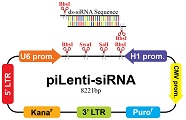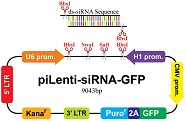
Custom siRNA Lentivirus Service
Choose our custom-made, ready-to-use iLenti™ and iLenti™-GFP siRNA for transfection or infection to knockdown your gene of interest!
- A single construct
- 4 constructs
- Guaranteed knockdown for any gene*
- Constructs available with a GFP reporter
- We take care of it all, at a fraction of the cost
Simply provide us with your gene’s accession number for any target gene or siRNA target sequence and we will create the lentivirus siRNA construct in as little as 2 weeks!
Once we begin your project, we will search our siRNA database of over 20,000 publications covering over 7,000 human and mouse genes. We will then design four constructs with high knockdown efficiency against the target sequence. If your gene of interest is not yet published, we will design four target sequences using our team’s years of expertise and advanced siRNA software. With four siRNA constructs, we guarantee that at least one of the constructs should give over 70% gene knockdown efficiency in appropriate target cells, with over 70% transfection efficiency for any human, mouse, or rat gene.
Don’t forget to include our ready-made scramble control construct for your experiments!
“The lentivirus (Cat. No. iV059988a) I received is working really well with my primary bone marrow stem cells. The transfection rate is nearly 70% in five days. Great product, I would like to continue to using your products”
Wei Guo, University of Maryland, siRNA Lentivirus
Additional Resources:
Service Details
| SERVICE | PRODUCT | SIZE | CAT. NO. |
| iLenti™ siRNA Cloning | 1 iLenti™-GFP Construct | 500ng | C043‑G |
| 1 iLenti™ Construct | 500ng | C043 | |
| 4 iLenti™-GFP Construct | 4 x 500ng | C044‑G | |
| 4 iLenti™ Construct | 4 x 500ng | C044 | |
| Negative Control Scramble Vector with GFP | 500ng | LV015‑G | |
| Negative Control Scramble Vector | 500ng | LV015 | |
| iLenti™ siRNA Lentivirus Production |
1 iLenti™-GFP Construct, Packaged Lentivirus (107 IU/ml) | 2 x 200μl | C043V‑G |
| 1 iLenti™ Construct, Packaged Lentivirus (107 IU/ml) | 2 x 200μl | C043V | |
| 4 iLenti™-GFP Constructs, Pooled Lentivirus (107 IU/ml) | 2 x 200μl | C044V‑G | |
| 4 iLenti™ Constructs, Pooled Lentivirus (107 IU/ml) | 2 x 200μl | C044V | |
| Scrambled siRNA GFP Lentivirus(107 IU/ml) | 2 x 200μl | LVP015‑G | |
| Scrambled siRNA Lentivirus(107 IU/ml) | 2 x 200μl | LVP015 |
Additional Info
Advantages of iLenti™ siRNA
- Choose siRNA in lentiviral vectors for either transfection or viral infection.
- iLenti™ vectors are very stable, no special competent cells are required.
- iLenti™ uses more potent 27-29 bp oligos.
- iLenti™ uses convergent promoters to avoid hairpin loop structures, making sequencing and plasmid growth much easier.
- Disclaimer
Our RNA interference lentiviral vectors contain siRNAs. We employ a dual-convergent promoter system where the sense and antisense strands of the siRNA are expressed by two different promoters rather than in a hairpin loop - this is to avoid any possible recombination events that can occur.
abm guarantees that at least one out of the four siRNA Lentivector constructs purchased in a set will result in over 70% knockdown of gene expression within target cells showing >80% transfection efficiency. If this is not the case, we will provide a one-time replacement of four new constructs with alternative siRNA sequences. To qualify for this replacement, the vectors must be transfected at ≥5 nM and assayed 48 hours post-transfection. Customers must provide adequate data to show >80% transfection efficiency with a positive control, plus additional qPCR data to evaluate the level of gene expression. The replacement set will not covered by the same guarantee, and if these constructs are also considered to be ineffective then, it is most likely the gene is not susceptible to siRNA knockdown.
abm limits its obligation and liability for the success of this technology to providing one replacement of any siRNA lentivector product only. Before sending your inquiry, please make sure you have extensively optimized your experiments, including (where applicable) increasing your MOI, increasing the duration of infection (up to 72 hours), and carrying out clone screening before assaying for knockdown. Please send all replacement inquiries and experimental data to technical@abmgood.com.
*Due to the unpredictable nature of customized knockdown, this guarantee does not apply to siRNAs designed 1) against species other than human, mouse, or rat, 2) against regions other than the coding region (CDS), or 3) with customer-provided siRNA target sequences. All sales are final for custom designs.
NOT FOR RESALE without prior written consent of abm. This product is distributed for laboratory research only. Caution: Not for diagnostic use.
FAQs
- Is your lentiviral system Tat-dependent or Tat-independent?
Tat-Independent.
- About the negative control (scramble), what is it? How do you know it is not targeting other genes? Also does it have any marker for me to say that the cells have got the control siRNA, but it is not bringing down my gene?
It is specifically designed that it should bring down any gene based on sequence search. Using antibiotics as your selection marker can show whether the negative control was successfully incorporated by the cell.
- How come I cannot see EGFP in my cells after infection with the iLenti-EGFP product? I have seen fluorescent activity with 293T cells but no fluorescent activity in my target cells (not 293T cells).
It is easy to see EGFP in 293 cells. Most of the other cell lines take about 48-73h to see the EGFP, and even then, the fluorescence activity may be low. The promoter strength for the EGFP gene varies with different cell line. Refer to the paper "Transgenes Delivered by Lentiviral Vector are Suppressed in Human Embryonic Stem Cells in a Promoter-Dependent Manner" by Xia et al. in Stem Cells and Development 16:167-176 (2007). EGFP expression is dependent on promoter strength, which may differ between different cell types. The promoter for the EGFP gene is from CMV. Even though the promoter is ubiquitous, the expression of EGFP may be suppressed in some target cells. That does not necessarily mean that the vector is not in the cells. The vector may be there and the siRNA may be expressed because the promoters for the siRNA are different. You can try Western blotting against the target gene product along with a standard curve to evaluate whether siRNA is being expressed and functional in the target cells.
- What generation is our iLenti-system?
iLenti is third generation lentivirus.
- What is our lentivirus based on?
Our system is based on inactivated HIV. All our packaging plasmids cannot be integrated into the host and they are transiently expressed only.
- What is the function of 3’ acceptor sites in lentiviral vectors?
It's for biosafety reason. The 5' splice donor and 3' acceptors sites enhance the biosafety of the vector by facilitating removal of the packaging sequence and RRE such that expression of the gene of interest in the transduced host cell is no longer Rev-dependent (Dull et al., 1998). It will inhibit viral production in stable cell lines.
- How do you ensure that your lentivirus is replication-defective?
We cannot send a protocol for you to view but I can summarize what we do to ensure the virus' replication deficiency. Lentiviral vector stocks are tested for the presence of replication-competent lentivirus (RCL) by monitoring p24 antigen expression in the culture medium of transduced 293T cells for 30 days. Serial passaging of the transduced p24 cells over this period allows for the amplification of RCL. Since the vectors are replication-defective, no amplification of p24 signal would normally be expected. However, if there were an increase in P24 signal over time, it would be indicative of RCL contamination. The p24 antigen is assayed with a commercial kit from http://www.zeptometrix.com/ . This assay has been performed on multiple vector lots without a positive result.
- How efficient is the lentivirus transduction?
This depends on the cell line or type as each one is different. In general, the lentivirus is very efficient in most cell lines with 100% for 293 and other commonly used cells. The lowest efficiency observed is 10% and customers have to do evolution for a specific cell line using EGFP lentivirus. For customers that just need to generate a stable cell line, 1% transduction efficiency is enough as every transduced cell is permanently integrated with the vector. Therefore, 10ml of 10^6 IU/ml would contain more than enough transduced cells.
- Does the final siRNA produced by this system have overhangs or not?
Once expressed in the host cell, Dicer will process the expressed dsRNA duplex into siRNA with 3' overhangs.
- I want to linearize the siRNA vector for electroporation purposes. Can you suggest a cut site outside the expression cassette that I can use?
HpaI or PacI will work to linearize the vector. Both sites are located outside of the LTRs.
- I am having difficulties linearizing my vector with PacI, can you suggest any reasons why this isn't working?
In our experience, PacI is an inefficient cutter and when carrying out in-house digests with this enzyme, we will normally do a 3 hour digestion. We suggest doing a 20-fold overdigestion at 3 hours to linearize the vector if you choose to use use this site.
- Can I use the BbsI sites shown on the map to cut the siRNA insert out of the vector?
The BbsI sites shown on the vector map of our siRNA constructs are used for cloning the siRNA inserts into the vector backbone. Once the cloning step is carried out these sites are destroyed and cannot be used to cut out the insert from the vector for further downstream applications.
- What primers can I use to sequence my vectors?
One forward sequencing reaction using the U6 primer should be sufficient: U6 forward sequencing primer 5'-TACGTCCAAGGTCGGGCAGGAAGA-3' You can use the H1 Primer to sequence in the reverse direction if required: H1 sequencing primer: 5'-CAACCCGCTCCAAGGAATCG-3'
Citations
| 01 |
Tamura, M et al. “Forkhead transcription factor FOXF1 is a novel target gene of the p53 family and regulates cancer cell migration and invasiveness.” Oncogene : (2013). 6:8371PubMed: 24186199 Application: siRNA.
|
| 02 |
Xin, H;Li, Y;Liu, Z;Wang, X;Shang, X;Cui, Y;Zhang, ZG;Chopp, M;, et al. “MiR-133b promotes neural plasticity and functional recovery after treatment of stroke with multipotent mesenchymal stromal cells in rats via transfer of exosome-enriched extracellular particles.” Stem Cells 12:2737-46 (2013). PubMed: 23630198
|
| 03 |
Fujiya, M;Konishi, H;Mohamed Kamel, MK;Ueno, N;Inaba, Y;Moriichi, K;Tanabe, H;Ikuta, K;Ohtake, T;Kohgo, Y;, et al. “microRNA-18a induces apoptosis in colon cancer cells via the autophagolysosomal degradation of oncogenic heterogeneous nuclear ribonucleoprotein A1.” Oncogene : (2013). PubMed: 24166503
|
| 04 |
Saghizadeh, M et al. “Enhanced wound healing, kinase and stem cell marker expression in diabetic organ-cultured human corneas upon MMP-10 and cathepsin F gene silencing.” Invest. Ophthalmol. Vis. Sci. 54:8172 – 80 (2013). DOI: 10.1167/iovs.13-13233 PubMed: 24255036 Application: siRNA.
|
| 05 |
Sasaki, Y et al. “CLCA2, a target of the p53 family, negatively regulates cancer cell migration and invasion..” Cancer Biology & Therapy 14:1512-1521 (2012). PubMed: 22990203 Application: siRNA.
|
| 06 |
Yokota, I et al. “Identification and characterization of early growth response 2, a zinc-finger transcription factor, as a p53-regulated proapoptotic gene..” International Journal of Oncology 6:1407-1416 (2010). PubMed: 21042708 Application: siRNA.
|
| 07 |
Jin, Q et al. “Decreased Tumor Progression and Invasion by a Novel Anti-Cell Motility Target for Human Colorectal Carcinoma Cells.” pLOS One 6:e66439 (0). PubMed: 23755307 Application: siRNA.
|
Search Library
RNAi Technology Library
We offer genome-wide libraries of siRNA and miRNA overexpression, inhibitors, UTR reporters, and qPCR primers for human, mouse, and rat in a full complement of viral and non-viral delivery systems.
Can’t find the cell line you’re looking for? Contact info@itsbio.co.kr.
abm web site 제품 검색 입니다.






